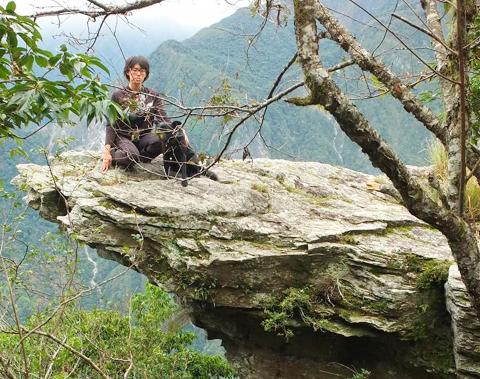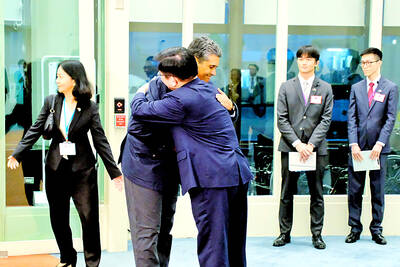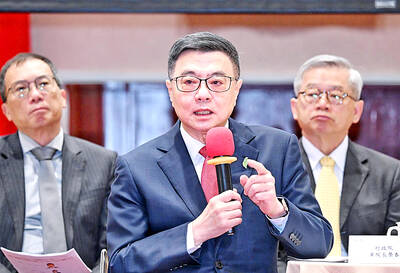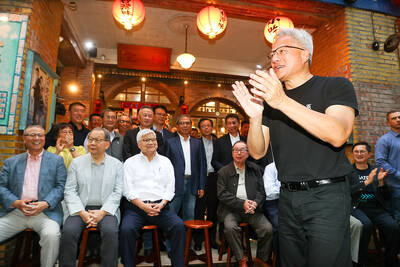A group of hikers that visited the Taroko National Park on Tuesday last week said they might have found a rock ledge, known as the “Tengu Rock,” that was depicted on postcards issued by the Hualien port authority during the Japanese colonial era, and had been thought to have been destroyed by a typhoon or earthquake.
Academics said that a collection of postcards were published between 1912 and 1926, including one named “Aborigine on a Cliff” (斷崖上的蕃人), which carried the caption: “The famous Tengu Rock under [the jurisdiction of] the Hualien port authority.”
The Tengu Rock had been frequently mentioned in official records and other literary texts of the time, academics said, adding that the location of the rock ledge as depicted on the postcard had never been found.

Photo courtesy of a climber surnamed Cheng
Rumors have been circulating for some time that the rock ledge was destroyed by natural disasters, academics said.
The group of hikers that found the rock had climbed Haishushan (海鼠山) and was walking along a path on the summit when one of them saw a rock ledge that looked very similar to the Tengu Rock featured on the postcards.
The rediscovery of the rock was welcomed by academics specializing in Hualien’s culture and history.
Academic Yeh Po-chiang (葉柏強) said the rediscovery was “excellent news,” but also called on hikers to have respect for nature and refrain from cutting down nearby trees in an attempt to recreate the exact scene as depicted on the postcards.
The hiking group’s leader, surnamed Cheng (鄭), said that the group did not originally plan to climb Haishushan, and that their finding of the ledge was entirely coincidental.
Cheng said he is worried that once the news spreads, many hikers would attempt to climb the mountain, which could cause unexpected changes to the terrain, such as possible overexposure to wind corrosion if a large number of climbers trample the grass near the rock.
The group announced its discovery as a gesture of acknowledgement to the Truku Aborigines living in the area, in the hope that it would help them preserve other natural formations there, Cheng said.
Prior to Japanese colonization, the area had been a part of the Truku’s hunting grounds, but was later occupied by the Japanese as a military base, Taroko National Park administration office deputy directory Chang Teng-wen (張登文) said.
The base served as a training ground for cavalry units and was connected to a hippodrome-like building, with military barracks at the foot of the mountain, Chang said, adding that most of the buildings have long since been removed.

RESOLUTIONS DEBATE: Taiwan’s allies said that UN and WHA resolutions cited by China and other nations ‘do not determine Taiwan’s participation in WHO activities’ A proposal to invite Taiwan to this year’s World Health Assembly (WHA) was rejected on Monday, resulting in Taipei’s absence from the annual meeting for a ninth consecutive year, although partners spoke up for Taiwan’s participation at the first day of the meeting. The first agenda item after the opening was a “two-on-two debate” on a proposal to invite Taiwan to participate at the WHA as an observer. Similar to previous years, two countries made statements in favor of the proposal, while two others expressed their opposition. Philippine Secretary of Health Teodoro Herbosa, president of the 78th WHA, accepted the WHA General Committee’s

Palauan President Surangel Whipps Jr arrived in Taiwan last night to kick off his first visit to the country since beginning his second term earlier this year. After arriving at Taoyuan International Airport at around 6:30 pm, Whipps and his delegation were welcomed by Minister of Foreign Affairs Lin Chia-lung (林佳龍). Speaking to gathered media, the Palauan leader said he was excited and honored to be back in Taiwan on his first state visit to Taiwan since he was sworn in this January. Among those traveling with Whipps is Minister of State Gustav N. Aitaro, Public Infrastructure

Premier Cho Jung-tai (卓榮泰) on Friday laid out the Cabinet’s updated policy agenda and recapped the government’s achievements ahead of the one-year anniversary of President William Lai’s (賴清德) inauguration. Cho said the government had made progress across a range of areas, including rebuilding Hualien, cracking down on fraud, improving pedestrian safety and promoting economic growth. “I hope the public will not have the impression that the Cabinet only asked the legislature to reconsider a bunch of legal amendments,” Cho said, calling the moves “necessary” to protect constitutional governance and the public’s interest. The Cabinet would work toward achieving its “1+7” plan, he said. The

Nvidia founder and CEO Jensen Huang (黃仁勳) hosted a dinner in Taipei last night with key Taiwanese suppliers to celebrate the successful mass production of the company’s new Blackwell AI systems. Speaking to the media earlier yesterday, Huang thanked Nvidia’s Taiwanese partners for their contributions to the company’s ecosystem, while also sharing his plans to meet with Taiwan Semiconductor Manufacturing Co (TSMC) founder Morris Chang (張忠謀). In response to rumors that Nvidia will launch a downgraded Hopper H20 chip for China in July, Huang dismissed the reports, saying, “That is not true.” He clarified that there